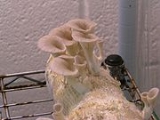
Pleurotus pulmonarius
Encyclopedia
Commonly known as the Indian Oyster, Phoenix Mushroom, or the Lung Oyster, Pleurotus pulmonarius is very similar to Pleurotus ostreatus, the pearl oyster, but has a few noticeable differences. The caps of pulmonarius are much paler and smaller than ostreatus and develops more of a stem. Pulmonarius also prefers warmer weather than ostreatus and will appear later in the summer. Otherwise, the taste and cultivation of the two species is generally described as largely the same. In North America
, P. pulmonarius also closely resembles Pleurotus populinus
, which is restricted to growing on aspen and cottonwood (genus Populus).
s while in the west it is commonly found on conifers.
colonises it to substrates of straw, wood chips, sawdust, cardboard, coffee grounds, and other cellulose-based substrates.
North America
North America is a continent wholly within the Northern Hemisphere and almost wholly within the Western Hemisphere. It is also considered a northern subcontinent of the Americas...
, P. pulmonarius also closely resembles Pleurotus populinus
Pleurotus populinus
Pleurotus populinus, the aspen oyster mushroom, is a gilled fungus native to North America. It is found on dead wood of aspen and cottonwood trees . Although morphologically similar to Pleurotus ostreatus and Pleurotus pulmonarius, it has been shown to be a distinct species incapable of...
, which is restricted to growing on aspen and cottonwood (genus Populus).
Natural Habitat
P. pulmonarius is widespread in temperate and subtropical forests throughout the world. In the eastern United States, this species is generally found on hardwoodHardwood
Hardwood is wood from angiosperm trees . It may also be used for those trees themselves: these are usually broad-leaved; in temperate and boreal latitudes they are mostly deciduous, but in tropics and subtropics mostly evergreen.Hardwood contrasts with softwood...
s while in the west it is commonly found on conifers.
Etymology and history
- 1821 First published as Agaricus pulmonarius by Fr.
- 1975 Disambiguated from Pleurotus sajor-caju by Pegler
Description
- PileusPileus (mycology)The pileus is the technical name for the cap, or cap-like part, of a basidiocarp or ascocarp that supports a spore-bearing surface, the hymenium. The hymenium may consist of lamellae, tubes, or teeth, on the underside of the pileus...
: 5 — 20+ cm, convex, becoming broadly convex to flat - Gills: Decurrent
- Spore Print: White to yellowish
- StipeStipe (mycology)thumb|150px|right|Diagram of a [[basidiomycete]] stipe with an [[annulus |annulus]] and [[volva |volva]]In mycology a stipe refers to the stem or stalk-like feature supporting the cap of a mushroom. Like all tissues of the mushroom other than the hymenium, the stipe is composed of sterile hyphal...
: Short and offset from the center of the cap - Taste:
- Odor:
- Microscopic features: Spores white to yellowish to lavender-gray when dense, more or less cylindrical, 7.5-11 x 3-4
Cultivation
The cultivation of Pleurotus Pulmonarius is very similar to how one would cultivate other types of Pleurotus species like P. Ostreatus by transferring its spores to grain spawn and then transferring the spawn after the myceliumMycelium
thumb|right|Fungal myceliaMycelium is the vegetative part of a fungus, consisting of a mass of branching, thread-like hyphae. The mass of hyphae is sometimes called shiro, especially within the fairy ring fungi. Fungal colonies composed of mycelia are found in soil and on or within many other...
colonises it to substrates of straw, wood chips, sawdust, cardboard, coffee grounds, and other cellulose-based substrates.

